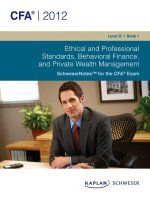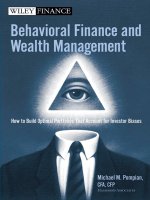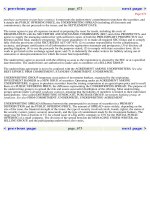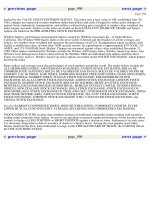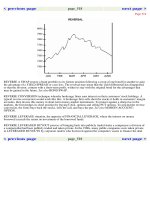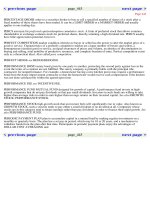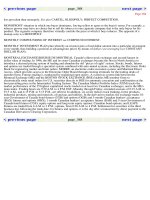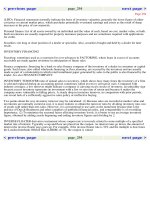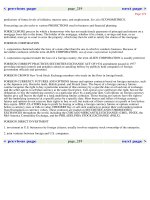R08 behavioral finance and investment processes
Bạn đang xem bản rút gọn của tài liệu. Xem và tải ngay bản đầy đủ của tài liệu tại đây (94.68 KB, 31 trang )
Reading 8
Behavioral Finance Investment Processes
www.irfanullah.co
Graphs, charts, tables, examples, and figures are copyright 2014, CFA Institute. Reproduced
and republished with permission from CFA Institute. All rights reserved.
Contents
1.
2.
3.
4.
5.
6.
7.
Introduction
The Uses and Limitations of Classifying Investors to Types
How Behavioral Factors Affect Adviser-Client Relations
How Behavioral Affect Portfolio Construction
Behavioral Finance and Analyst Forecasts
How Behavioral Factors Affect Committee Decision Making
How Behavioral Finance Influences Market Behavior
www.irfanullah.co
2
1. Introduction
• Behavioral finance challenges assumption that individuals act
rationally
• Investor classification based on behavioral characteristics
• Behavioral factors impact…
– Adviser-client relationships
– Portfolio construction
– Committee decision making
– Market behavior
www.irfanullah.co
3
2. The Uses and Limitations of Classifying Investors into Types
Psychographic Profile Behavior
Confident
Exhibit 1
BB&K Model
Bailard,
Biehl
and
Kieser
Straight
Arrow
Careful
Impetuous
Anxious
Exercise: draw model and identify where you fit
www.irfanullah.co
4
Exhibit 2
• Adventurer
• Celebrity
www.irfanullah.co
5
Exhibit 2
• Individualist
• Guardian
• Straight Arrow
www.irfanullah.co
6
Behavioral Alpha Approach
A top-down approach to bias-identification
1. Interview client
a. Indentify active or passive traits
b. Determine risk tolerance
Read the 9 questions
2. Plot investor on active/passive scale and risk tolerance scale
3. Test for behavioral biases
Exhibit 3
Exhibit 4
4. Classify investor into a behavioral investment type
www.irfanullah.co
7
Exhibit 4: Biases Associated with Each Behavioral Investor Type
General Type
Risk Tolerance
Passive
Active
Low
High
Investment Style
Bias Type
BIT
Emotional
Biases
Cognitive
Biases
www.irfanullah.co
8
Exhibit 5: Behavioral Investor Type Diagnostic Process
www.irfanullah.co
9
Passive Preserver (PP)
Emphasis on financial security and preserving wealth
Focus on taking care of future generations
Some are ‘worriers’ slow to change
What are the common biases?
Advising PPs:
Difficult to advise because they are driven by emotion
Focus on what money will accomplish
www.irfanullah.co
10
Friendly Follower (FF)
Want to be in latest most popular investments
Often overestimate risk tolerance
What are the common biases?
Advising FFs:
Mainly cognitive biases hence education is effective
Encourage FFs to understand implications of investment options
www.irfanullah.co
11
Independent Individualist (II)
Strong willed, Independent
Enjoy investing
What are the biases?
Advising IIs:
Listen to advise when presented in a way that respects their intelligence
Regular educational sessions
www.irfanullah.co
12
Active Accumulator (AA)
Most aggressive behavioral investor type
Entrepreneurial , quick decision makers
High portfolio turnover
What are the biases?
Hands-on
Advising AAs:
Advisers need to prove to client that they have ability to make wise,
objective and long term decisions
www.irfanullah.co
13
2.2 Limitations of Classifying Investors
1. Exhibit both cognitive and emotional biases
2. Exhibit characteristics of multiple investor types
3. Behavioral changes
4. Unique treatment
5. Irrational and unpredictable
www.irfanullah.co
14
3. How Behavioral Factors Affect Client-Adviser Relations
Aspect of Client-Adviser
Relationship
Behavioral Considerations
Formulating Financial Goals
Maintaining a Consistent
Approach
Investing as the Client Expects
Ensuring Mutual Benefits
www.irfanullah.co
15
Limitations of Traditional Risk Tolerance Questionnaires
Generally firms require advisers to use a standard tolerance questionnaire
Recognize that these questionnaires have limitations:
Ignore behavioral biases
How are questions framed
How are questions interpreted
www.irfanullah.co
16
4. How Behavioral Factors Affect Portfolio Construction
Inertia and Default
Response: Target Date Fund
Read Example 1
Naïve Diversification
Simple heuristics
Framing bias
1/n diversification
www.irfanullah.co
17
Company Stock: Investing in the Familiar
Familiarity and overconfidence effects
Naïve extrapolation of past returns
Framing and status quo effect of matching contributions
Loyalty effects
Financial incentives
www.irfanullah.co
18
Excessive Trading
Home Bias
www.irfanullah.co
19
Behavioral Portfolio Theory
www.irfanullah.co
20
5. Behavioral Finance and Analyst Forecasts
Overconfidence in Forecasting Skills
Illusion of knowledge bias
Remedial Actions:
Self attribution bias
Prompt and accurate feedback
Representativeness
Structure that rewards accuracy
Availability bias
Learn to use Bayes’ Formula… properly
Hindsight bias
Example 3
Example 2
www.irfanullah.co
21
Influence of Company’s Management on Analysis
What information is presented
External Analysts
How is the information presented
Faming Bias (see Exhibit 9)
Anchoring and Adjustment Bias Analysis influence by initial default position or anchor
Availability Bias Greater importance to more easily available information
Remedial Action: Disciplined and Systematic Approach
www.irfanullah.co
22
Analyst Biases in Conducting Research
Excessive unstructured information Illusion of knowledge Overconfidence
Representativeness Bias: Analyst estimates probability of forecast based on how much
outcome resembles available data
Confirmation Bias
Gamblers’ Fallacy: analysts wrongly project reversal to mean in a give time period
Example 4
“stock market will decline in the near future and then rise…”
Conjunction fallacy
Fact: probability of two independent happening is always less than probability of either event
www.irfanullah.co
23
Remedial Actions for Analyst Biases in Conducting Research
Focus on objective data
Systematic and structured approach
Follow Standard V: Investments Analysis, Recommendations and Actions
Seek contrary facts and opinions
Prompt feedback
Documentation and record retention
www.irfanullah.co
24
6. How Behavioral Factors Affect Committee
Decision Making
Social Proof Bias: Individuals biased to follow beliefs of a group
Group decision Overconfidence Bias
Solution
Investment Committee Dynamics
Diversity in skills, experience and
culture
What happens to nail that sticks out?
Committees do not learn from experience
Respect for different views
Collect individual views before
meeting
www.irfanullah.co
25
